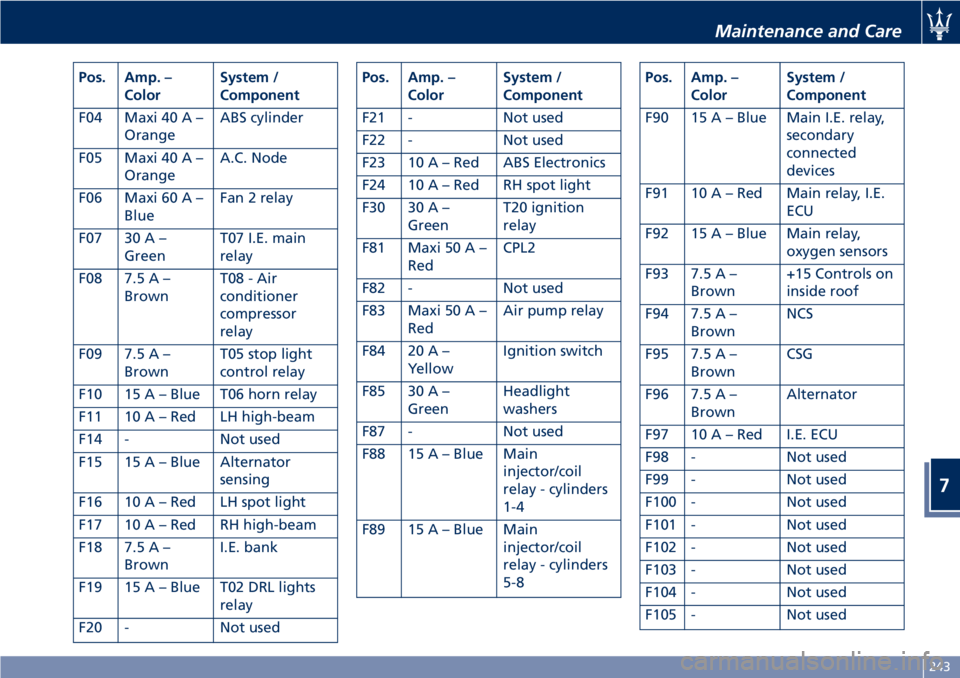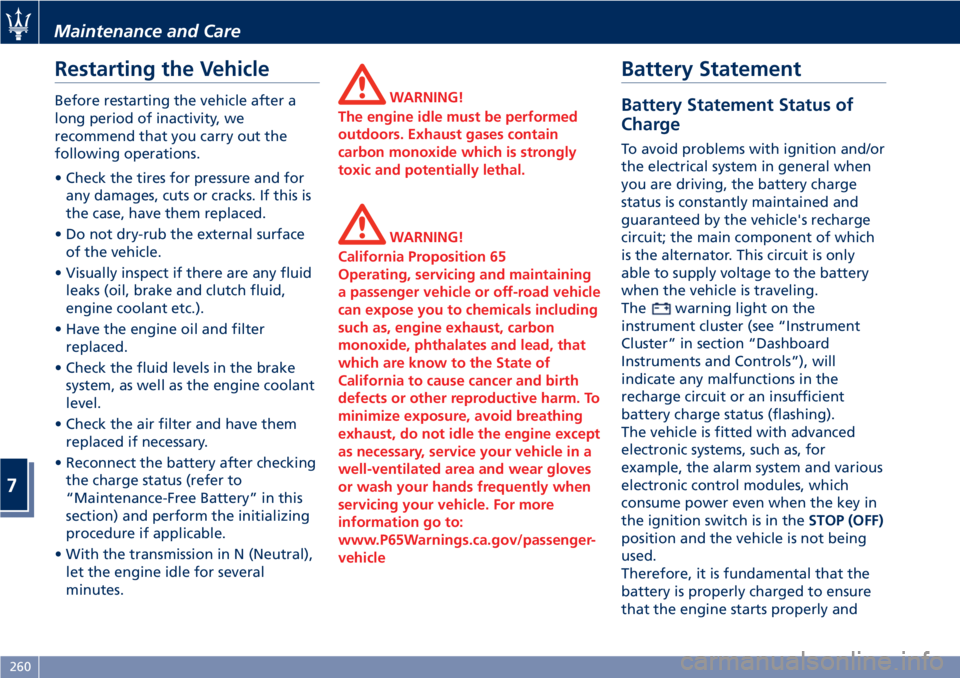2020 MASERATI GRANTURISMO alternator
[x] Cancel search: alternatorPage 218 of 286

Auxiliary Jump-Start
Procedure
If your vehicle has a discharged battery
it can be jump-started using a set of
jumper cables and a battery of another
vehicle or by using a portable battery
booster. It is necessary to have proper
jumper cables in order to connect the
booster battery to the remote posts of
the discharged battery. Booster cables
have usually positive and negative
terminal clamps and are identified by a
different sheath color (red = positive,
black = negative). Maserati provides
on request jumper cables created for
its models and content in a practical
case.
NOTE:
TheAuthorized Maserati Dealercan
provide you with information about
the “Maserati Jumper Cables Kit”,
available in the “Genuine Accessories”
range.
Jump-starting can be dangerous if
done improperly so please follow the
procedures in this section carefully.NOTE:
When using a portable battery booster
pack, follow the battery
manufacturer’s operating instructions
and precautions.
CAUTION!
• To jump start a vehicle do not use a
portable battery, a booster pack or
any other booster source with a
system voltage greater than 14 Volts
or damage to the battery, starter
motor, alternator or electrical system
of the vehicle with the discharged
battery may occur.
• Do not use a battery charger for
emergency starting under any
circumstances. You could damage the
electronic systems, particularly the
control units managing the ignition
and fuel supply functions.
• If the battery is completely
discharged when the windows are
fully raised, open the door with the
utmost care; do not close the door
again until it is possible to lower the
window.
WARNING!
•Using booster packs that have not
been checked, which could therefore
release a too high charging voltage
(higher than 14 V), in extreme
environmental conditions (for
example: closed areas or without
proper ventilation and temperatures
higher than 122°F/50°C or lower
than -4°F/-20°C) create the right
conditions for ignition which could
then cause the battery to explode.
Therefore you shall always perform
jump-starting operations using the
adequate tools and in the best
environmental conditions, taking all
necessary precautions.
•Do not attempt jump-starting if the
discharged battery is frozen. It could
rupture or explode during jump start
and cause personal injury.
•Do not carry out this procedure if
you have not done it before:
incorrect maneuvers can originate
high electrical discharges and even
cause the battery to explode.
•To avoid the risk of explosion or fire,
do not approach the battery with
In an Emergency
6
214
Page 228 of 286

Scheduled Service Plan
The Scheduled Maintenance services
listed in this chapter must be done
within the times or mileages specified
to protect your vehicle warranty and
ensure the best vehicle performance
and reliability.
More frequent maintenance may be
needed for vehicles in severeoperating conditions, such as dusty
areas and very short trip driving.
Inspection and service should also be
done anytime a malfunction is
suspected.
Maserati recommends that these
maintenance intervals be performed at
theAuthorized Maserati Dealer. Thetechnicians at your dealership know
your vehicle best, and have access to
factory-approved information,
genuine Maserati parts, and specially
designed electronic and mechanical
tools that can help prevent future
costly repairs.
Main Operations/Service Coupons
Service coupons 1° 2° 3° 4° 5° 6° 7° 8° 9° 10° 11° 12°
Main operations Maintenance schedules: every 12500 mi (20000 km) or 2 years
Belt for alternator, air conditioning
compressor and hydraulic steering controlI I* I I* I I* I I* I I* I I*
Replace at least every 2 years
Poly-V flexible control belt for water
pumpIIIIRIIIIRII
Replace every time the part is removed
Engine oil and filterRRRRRRRRRRRR
Replace at least every 2 years
Cooling system connections and linesI I*I*I*I*I*I* I*I*I*I*I*
Air filterR R* R R* R R* R R* R R* R R*
Fuel injection system’s connections and
linesI I* I I* I I*
Ignition system: cables and connectionsI I* I I* I I*
Spark plugsRR
Active carbon filter and Lambda sensorsR
Replace at least every 4 years
Maintenance and Care
7
224
Page 230 of 286

Service coupons 1° 2° 3° 4° 5° 6° 7° 8° 9° 10° 11° 12°
Main operations Maintenance schedules: every 12500 mi (20000 km) or 2 years
Tightening of screws, nuts and bolts
(including those for the exhaust system),
connections, retaining clips and clampsIIIIIIIIIIII
Pollen filterRRRRRRRRRRRR
Replace every 2 years. In the event that the vehicle is frequently used in
dusty or strongly polluted environments, a more frequent replacement is
recommended
Starter motor and alternator: power
absorption and chargeIII II
Vehicle geometry checkIIIIIIIIIIII
Controls and adjustment systems in
general, hinges, doors, front and rear lidIIIIIIIIIIII
Correct operation and reliability of the
seats and seat beltsIIIIIIIIIIII
Fastening screws and nuts on the
bodyworkIIIIIIII
Headlight aimingIIIIIIIIIIII
Chassis and protected area intactnessIIIIIIIIIIII
Check every 2 years
Vehicle road test (any time this may be
necessary)IIIIIIIIIIII
Check with diagnostics systemIIIIIIIIIIII
Maintenance and Care
7
226
Page 247 of 286

Pos. Amp. –
ColorSystem /
Component
F04 Maxi 40 A –
OrangeABS cylinder
F05 Maxi 40 A –
OrangeA.C. Node
F06 Maxi 60 A –
BlueFan 2 relay
F07 30 A –
GreenT07 I.E. main
relay
F08 7.5 A –
BrownT08 - Air
conditioner
compressor
relay
F09 7.5 A –
BrownT05 stop light
control relay
F10 15 A – Blue T06 horn relay
F11 10 A – Red LH high-beam
F14 - Not used
F15 15 A – Blue Alternator
sensing
F16 10 A – Red LH spot light
F17 10 A – Red RH high-beam
F18 7.5 A –
BrownI.E. bank
F19 15 A – Blue T02 DRL lights
relay
F20 - Not usedPos. Amp. –
ColorSystem /
Component
F21 - Not used
F22 - Not used
F23 10 A – Red ABS Electronics
F24 10 A – Red RH spot light
F30 30 A –
GreenT20 ignition
relay
F81 Maxi 50 A –
RedCPL2
F82 - Not used
F83 Maxi 50 A –
RedAir pump relay
F84 20 A –
YellowIgnition switch
F85 30 A –
GreenHeadlight
washers
F87 - Not used
F88 15 A – Blue Main
injector/coil
relay - cylinders
1-4
F89 15 A – Blue Main
injector/coil
relay - cylinders
5-8Pos. Amp. –
ColorSystem /
Component
F90 15 A – Blue Main I.E. relay,
secondary
connected
devices
F91 10 A – Red Main relay, I.E.
ECU
F92 15 A – Blue Main relay,
oxygen sensors
F93 7.5 A –
Brown+15 Controls on
inside roof
F94 7.5 A –
BrownNCS
F95 7.5 A –
BrownCSG
F96 7.5 A –
BrownAlternator
F97 10 A – Red I.E. ECU
F98 - Not used
F99 - Not used
F100 - Not used
F101 - Not used
F102 - Not used
F103 - Not used
F104 - Not used
F105 - Not used
Maintenance and Care
7
243
Page 264 of 286

Restarting the Vehicle
Before restarting the vehicle after a
long period of inactivity, we
recommend that you carry out the
following operations.
• Check the tires for pressure and for
any damages, cuts or cracks. If this is
the case, have them replaced.
• Do not dry-rub the external surface
of the vehicle.
• Visually inspect if there are any fluid
leaks (oil, brake and clutch fluid,
engine coolant etc.).
• Have the engine oil and filter
replaced.
• Check the fluid levels in the brake
system, as well as the engine coolant
level.
• Check the air filter and have them
replaced if necessary.
• Reconnect the battery after checking
the charge status (refer to
“Maintenance-Free Battery” in this
section) and perform the initializing
procedure if applicable.
• With the transmission in N (Neutral),
let the engine idle for several
minutes.WARNING!
The engine idle must be performed
outdoors. Exhaust gases contain
carbon monoxide which is strongly
toxic and potentially lethal.
WARNING!
California Proposition 65
Operating, servicing and maintaining
a passenger vehicle or off-road vehicle
can expose you to chemicals including
such as, engine exhaust, carbon
monoxide, phthalates and lead, that
which are know to the State of
California to cause cancer and birth
defects or other reproductive harm. To
minimize exposure, avoid breathing
exhaust, do not idle the engine except
as necessary, service your vehicle in a
well-ventilated area and wear gloves
or wash your hands frequently when
servicing your vehicle. For more
information go to:
www.P65Warnings.ca.gov/passenger-
vehicle
Battery Statement
Battery Statement Status of
Charge
To avoid problems with ignition and/or
the electrical system in general when
you are driving, the battery charge
status is constantly maintained and
guaranteed by the vehicle's recharge
circuit; the main component of which
is the alternator. This circuit is only
able to supply voltage to the battery
when the vehicle is traveling.
The
warning light on the
instrument cluster (see “Instrument
Cluster” in section “Dashboard
Instruments and Controls”), will
indicate any malfunctions in the
recharge circuit or an insufficient
battery charge status (flashing).
The vehicle is fitted with advanced
electronic systems, such as, for
example, the alarm system and various
electronic control modules, which
consume power even when the key in
the ignition switch is in theSTOP (OFF)
position and the vehicle is not being
used.
Therefore, it is fundamental that the
battery is properly charged to ensure
that the engine starts properly and
Maintenance and Care
7
260